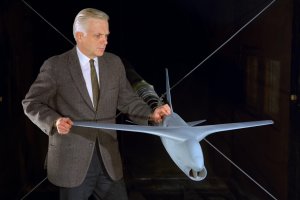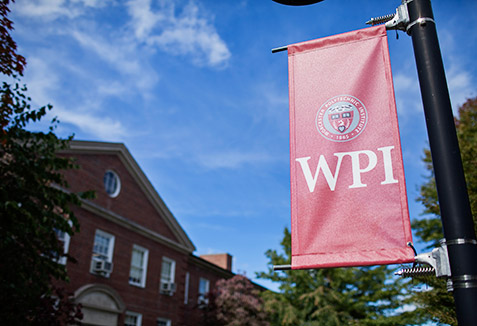
Whitcomb in 1970 with a model used in wind
tunnel tests of his supercritical wing innovation.
The first forays into transonic flight were accomplished with brute strength, starting with Chuck Yeager's history-making 1947 flight in the rocket-powered Bell X-1. But flying faster than sound proved much more difficult for jet aircraft, which experienced shock waves and power-sapping drag near the sound barrier.
The man who solved that problem, and made supersonic flight a practical reality, recently received one of aviation's greatest honors. Richard Whitcomb ’43, who died in 2009 at the age of 88, was inducted posthumously into the Aviation Hall of Fame in October, joining such luminaries as the Wright brothers, Amelia Earhart, Neil Armstrong, and WPI's own Robert Goddard '08.
Whitcomb, an Illinois native who spent his teenage years in Worcester, earned a degree in mechanical engineering at WPI and got a job at the Langley Research Center, run by the National Advisory Committee for Aeronautics (now NASA). There, he became known for his intuitive sense of air flow and aeronautics.
Whitcomb spent hours observing models in Langley's transonic wind tunnel. The observations led to a brilliant insight and an ingenious solution, one that remains a fundamental tenet of supersonic aircraft design. Called the Area Rule, it says that drag at high speeds is a function of an airplane's total cross-sectional area (essentially, the thickness of the fuselage). Because projections from the fuselage increase a plane's cross section, narrowing the fuselage where the wings and tail assembly attach reduces drag.
The idea was first tested on the Convair YF-102, a delta-winged jet fighter that had not performed well at transonic speeds. The plane was lengthened and given the now-famous "Coke-bottle" fuselage; in the words of a test pilot, the redesigned plane "slipped right past the sound barrier and kept on going." (The wind-tunnel model Whitcomb used to develop the Area Rule is in the collection of the Smithsonian's National Air and Space Museum.)
Later in his NASA career, Whitcomb drew on his uncanny intuition to make two other groundbreaking contributions to aeronautical design: the supercritical wing, which delays the onset of drag at high speeds, and winglets, airfoils that jut up from wingtips and reduce drag-inducing vortices. Both have been widely adopted, resulting in substantial fuel savings in military and commercial aviation.
At the time of his death, NASA remembered Whitcomb as “the most significant aerodynamic contributor of the second half of the 20th century." Whitcomb's nomination for the Aviation Hall of Fame was endorsed by Langley director Lesa Roe, Apollo 8 astronaut Bill Anders, and Neil Armstrong. Armstrong's biographer, Jim Hansen, called Whitcomb "the Leonardo da Vinci of American Aerodynamics."
Whitcomb's Hall of Fame induction was the latest in a long list of distinguished honors. They include the Collier Trophy, aviation's most distinguished award; the National Medal of Science; induction into the Inventors Hall of Fame; and induction into the Paul E. Garber First Flight Shrine at the Wright Brothers National Memorial visitor's center in Kitty Hawk, N.C. WPI honored Whitcomb with its Presidential Medal (2003) and an honorary doctorate in engineering (1956).
Whitcomb left his alma mater a collection of his papers and awards, including the Collier Trophy. You can see the awards in the new Innovators exhibit in the Gordon Library, where they sit alongside artifacts from the careers of Goddard and other notable WPI alumni.
- Watch a NASA video about Whitcomb’s contributions to aviation.
- Read a 2002 profile of Richard Whitcomb in WPI’s alumni magazine.
- Learn more about Whitcomb’s discovery of the Area Rule in this 1990 article from Smithsonian Air & Space magazine.
- Read Richard Whitcomb's obituary in the Wall Street Journal.
- Read the citation for Whitcomb’s 1956 WPI honorary degree and his 2003 WPI Presidential Medal.

